Related Research Articles
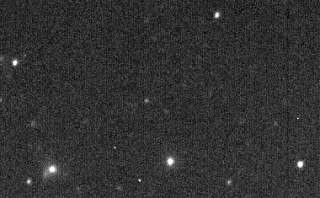
Erriapus, or Saturn XXVIII (28), is a prograde irregular satellite of Saturn. It was discovered by Brett Gladman, John J. Kavelaars and colleagues in 2000, and given the temporary designation S/2000 S 10. It was named Erriapo in August 2003 after Erriapus, a giant in Gaulish mythology; the name was changed from dative Erriapo to nominative Erriapus per IAU conventions in late 2007.

Mundilfari, or Saturn XXV, is a natural satellite of Saturn. It was discovered by Brett J. Gladman, et al. in 2000, and given the temporary designation S/2000 S 9. Mundilfari is about 7 kilometres in diameter, and orbits Saturn at an average distance of 18,5903 Mm in 952.95 days, at an inclination of 168.4° to the ecliptic, in a retrograde direction and with an eccentricity of 0.210.

Thrymr, or Saturn XXX, is a natural satellite of Saturn. It was discovered by Gladman and colleagues in 2000, and given the temporary designation S/2000 S 7. Its name comes from Norse mythology, where Thrymr is a Jotun.

Narvi or Saturn XXXI is a natural satellite of Saturn. It was discovered by a team of astronomers led by Scott S. Sheppard in 2003, and given the temporary designation S/2003 S 1.
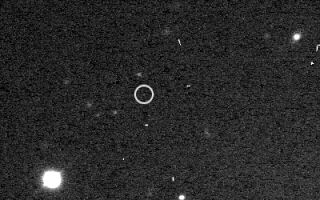
Suttungr, or Saturn XXIII, is a natural satellite of Saturn. It was discovered by Brett J. Gladman, et al. in 2000, and given the temporary designation S/2000 S 12. It was named for Suttungr in Norse mythology, a Jötunn or giant who once owned the mead of poetry.
Fenrir, or Saturn XLI, is a natural satellite of Saturn. Its discovery was announced by Scott S. Sheppard, David C. Jewitt, Jan Kleyna, and Brian G. Marsden on May 4, 2005, from observations taken between December 13, 2004, and March 5, 2005. Fenrir has an apparent magnitude of 25, making it one of the faintest known moons in the Solar System, and was discovered using some of the largest telescopes in the world. It is even too dark to have been observed by the Cassini spacecraft when it was in orbit around Saturn, for which it never got brighter than approximately 17th apparent magnitude. Fenrir was named after Fenrisulfr, a giant wolf from Norse mythology, father of Hati and Skoll, son of Loki, destined to break its bonds for Ragnarök.

Fornjot or Saturn XLII is the outermost named moon of Saturn. Its discovery was announced by Scott S. Sheppard, David C. Jewitt, Jan Kleyna, and Brian G. Marsden on 4 May 2005 from observations taken between 12 December 2004, and 11 March 2005. It had the largest semi-major axis among all the known moons of Saturn

Hati or Saturn XLIII is a natural satellite of Saturn. Its discovery was announced by Scott S. Sheppard, David C. Jewitt, Jan Kleyna, and Brian G. Marsden on 4 May 2005, from observations taken between 12 December 2004 and 11 March 2005.
Farbauti or Saturn XL is a natural satellite of Saturn. Its discovery was announced by Scott S. Sheppard, David C. Jewitt, Jan Kleyna, and Brian G. Marsden on May 4, 2005, from observations taken between December 12, 2004, and March 9, 2005.
S/2004 S 7 is a natural satellite of Saturn. Its discovery was announced by Scott S. Sheppard, David C. Jewitt, Jan Kleyna, and Brian G. Marsden on 4 May 2005 from observations taken between 12 December 2004 and 8 March 2005.

Bestla or Saturn XXXIX is a retrograde irregular moon of Saturn. Its discovery was announced by Scott S. Sheppard, David C. Jewitt, Jan Kleyna, and Brian G. Marsden on 4 May 2005, from observations taken between 13 December 2004 and 5 March 2005.

Bergelmir or Saturn XXXVIII is a natural satellite of Saturn. Its discovery was announced by Scott S. Sheppard, David C. Jewitt, Jan Kleyna, and Brian G. Marsden on May 4, 2005, from observations taken between December 12, 2004, and March 9, 2005.

Bebhionn, also known as Saturn XXXVII, is a small, irregular natural satellite of Saturn. Its discovery was announced by Scott S. Sheppard, David C. Jewitt, Jan Kleyna, and Brian G. Marsden on 4 May 2005 from observations taken between 12 December 2004 and 9 March 2005.

Hyrrokkin or Saturn XLIV is a natural satellite of Saturn. Its discovery was announced by Scott S. Sheppard, David C. Jewitt, Jan Kleyna, and Brian G. Marsden on June 26, 2006, from observations taken between December 12, 2004, and April 30, 2006.

Kari or Saturn XLV is a natural satellite of Saturn. Its discovery was announced by Scott S. Sheppard, David C. Jewitt, Jan Kleyna, and Brian G. Marsden on 26 June 2006 from observations taken between January and April 2006.
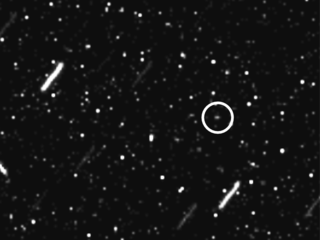
Greip or Saturn LI is a natural satellite of Saturn. Its discovery was announced by Scott S. Sheppard, David C. Jewitt, Jan Kleyna, and Brian G. Marsden on 26 June 2006, from observations taken between 5 January and 1 May 2006. Greip is about 5 kilometres in diameter, and orbits Saturn at an average distance of 18,066 Mm in 906.556 days, at an inclination of 172.7° to the ecliptic, in a retrograde direction and with an eccentricity of 0.3735, and is presumably at high risk of eventually colliding with Phoebe. It is unknown whether Greip is more similar to Suttungr or Hyrrokkin in color. Its rotation period is most likely 12.75±0.35 hours with two minima in the light curve, but a longer period of 19 hours cannot be ruled out due to the short observation time by Cassini–Huygens.
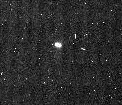
Loge or Saturn XLVI is a natural satellite of Saturn. Its discovery was announced by Scott S. Sheppard, David C. Jewitt, Jan Kleyna, and Brian G. Marsden on 26 June 2006, from observations taken between January and April 2006.
Jarnsaxa, also known as Saturn L, is a natural satellite of Saturn. Its discovery was announced by Scott S. Sheppard, David C. Jewitt, Jan Kleyna, and Brian G. Marsden on June 26, 2006, from observations taken between January 5 and April 29, 2006.
Surtur or Saturn XLVIII is a natural satellite of Saturn. Its discovery was announced by Scott S. Sheppard, David C. Jewitt, Jan Kleyna, and Brian G. Marsden on June 26, 2006 from observations taken between January and April 2006. It was named after Surt, a leader of the fire giants of Norse mythology.
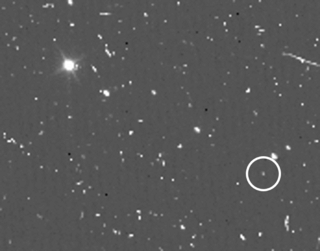
Skoll or Saturn XLVII is a retrograde irregular satellite of Saturn. Its discovery was announced by Scott S. Sheppard, David C. Jewitt and Jan Kleyna on 26 June 2006 from observations taken between 5 January and 30 April 2006.
References
- ↑ Ma, Yuehua; et al. (2010), "On the Origin of Retrograde Orbit Satellites around Saturn and Jupiter", Icy Bodies of the Solar System, Proceedings of the International Astronomical Union, IAU Symposium, vol. 263, pp. 157–160, Bibcode:2010IAUS..263..157M, doi: 10.1017/S1743921310001687 .
- ↑ Denk, Tilmann; Mottola, Stefano; Tosi, Frederico; Bottke, William F.; Hamilton, Douglas P. (2018). "The Irregular Satellites of Saturn" (PDF). In Schenk, P.M.; Clark, R.N.; Howett, C.J.A.; Verbiscer, A.J.; Waite, J.H. (eds.). Enceladus and the Icy Moons of Saturn. Space Science Series. Vol. 322. Tucson, AZ: The University of Arizona Press. pp. 409–434. Bibcode:2018eims.book..409D. doi:10.2458/azu_uapress_9780816537075-ch020. ISBN 9780816537075.
- ↑ "Final Results of NameExoWorlds Public Vote Released". International Astronomical Union. 15 December 2015. Retrieved 2017-09-25.
- ↑ Merriam-Webster's Encyclopedia of Literature (1995)
- ↑ "Aegir". Dictionary.com Unabridged (Online). n.d.
- ↑ Harold Stanford (1922), The Standard Reference Work: For the Home, School and Library